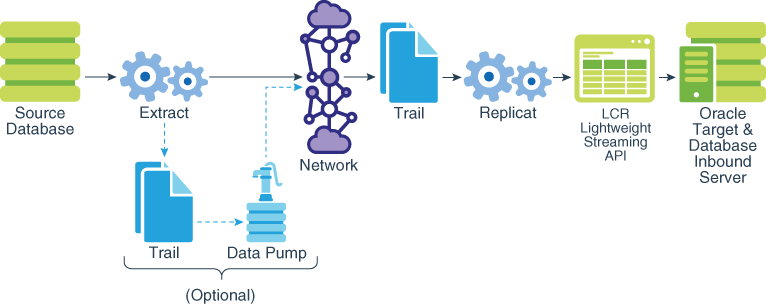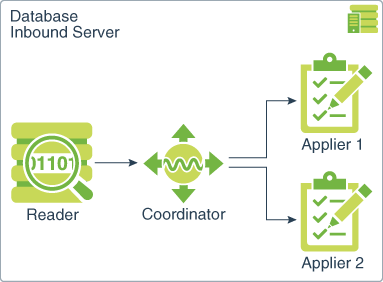About Integrated Replicat
In integrated mode, the Replicat process leverages the apply processing functionality that is available within the Oracle Database. In this mode, Replicat operates as follows:
-
Reads the Oracle GoldenGate trail.
-
Performs data filtering, mapping, and conversion.
-
Constructs logical change records (LCR) that represent source database DML transactions (in committed order). DDL is applied directly by Replicat.
-
Attaches to a background process in the target database known as a database inbound server by means of a lightweight streaming interface.
-
Transmits the LCRs to the inbound server, which applies the data to the target database.
The following figure illustrates the configuration of Replicat in integrated mode.
Within a single Replicat configuration, multiple inbound server child processes known as apply servers apply transactions in parallel while preserving the original transaction atomicity. You can increase this parallelism as much as your target system will support when you configure the Replicat process or dynamically as needed. The following diagram illustrates integrated Replicat configured with two parallel apply servers.
Integrated Replicat applies transactions asynchronously. Transactions that do not have interdependencies can be safely executed and committed out of order to achieve fast throughput. Transactions with dependencies are guaranteed to be applied in the same order as on the source.
A reader process in the inbound server computes the dependencies among the transactions in the workload based on the constraints defined at the target database (primary key, unique, foreign key). Barrier transactions and DDL operations are managed automatically, as well. A coordinator process coordinates multiple transactions and maintains order among the apply servers.
If the inbound server does not support a configured feature or column type, Replicat disengages from the inbound server, waits for the inbound server to complete transactions in its queue, and then applies the transaction to the database in direct apply mode through OCI. Replicat resumes processing in integrated mode after applying the direct transaction.
The following features are applied in direct mode by Replicat:
-
DDL operations
-
Sequence operations
-
SQLEXECparameter within aTABLEorMAPparameter -
EVENTACTIONSprocessing -
UDTNote:
By default, UDT's are applied with the inbound server. Only ifNOUSENATIVEOBJSUPPORTis in place, then Extract handling is done by Replicat directly.
Because transactions are applied serially in direct apply mode, heavy use of such operations may reduce the performance of the integrated Replicat mode. Integrated Replicat performs best when most of the apply processing can be performed in integrated mode, see Monitoring and Controlling Processing After the Instantiation in .
Note:
User exits are executed in integrated mode. However, user exit may produce unexpected results, if the exit code depends on data in the replication stream.
Note:
Integrated Replicat requires that any foreign key columns are indexed.
